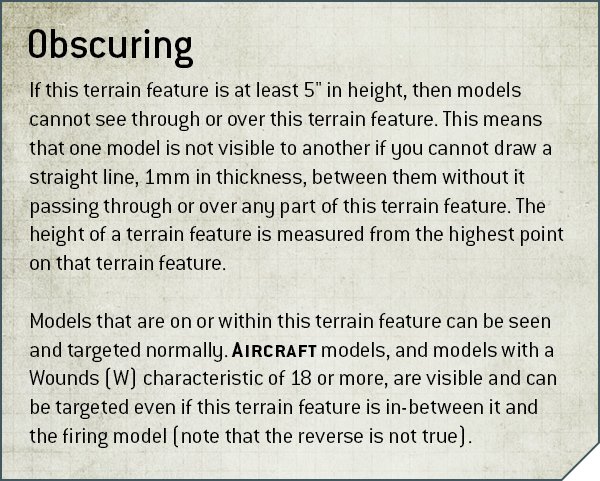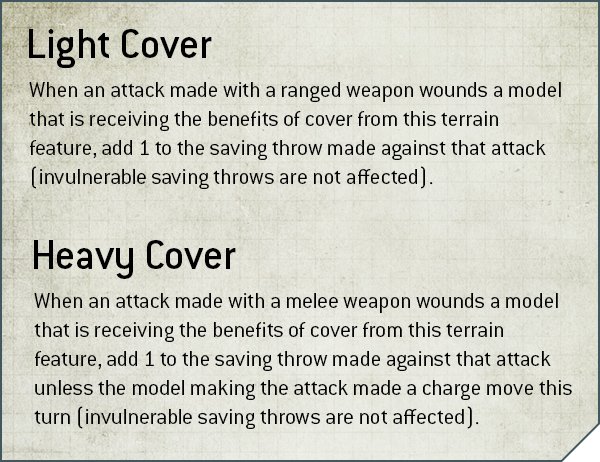The Warhammer Community team dropped a large helping of information on Terrain today, with a new article on Warhammer Community as well as a discussion between Stu Black and Eddie Eccles on Warhammer TV. While we don’t normally publish these as posts, we transcribe them to use when we do our weekly round-up of rules. However they’ve proven really popular and so we figured we may as well share them with a few thoughts. We’ll still be rounding up the whole week’s worth of information in our Saturday posts, and for more on the new Vehicle rules revealed on Tuesday, check out today’s Ruleshammer on Big Guns Never Tire.
Overall Statement:
The goal is to make terrain an equal player in the game, “equal to a third army.” Terrain rules are what has changed the most from last edition. These rules are meant to be more meaningful and interactive. Line of Sight will be cut down a lot more. 40K has been very deadly and units need to be able to hide, particularly in first turn. The intent is to make the game more based on movement and have a dynamic feel and create a justification for things like outflanking.
Also: More cool terrain and models are on the way. (GREGNOTE: Why do they bother, when Moon Base Klaisus already exists)
There are Four Terrain Categories in 9th Edition
- Hills (literal physical objects) – these retain their rules from 8th edition as “considered to be part of the battlefield” and offer no protection or benefits
- Obstacles (barrier, walls) – offer cover, which will usually mean +1 to saving throws against ranged weapons for INFANTRY, BEASTS, and SWARMS if the obstacle is between you and the firing unit
- Area Terrain (clearly defined terrain bases like woods, swamps, ruins) – the benefits of these will depend on their Terrain Traits (see below)
- Buildings (units) – fortifications, usually
Terrain Traits
Terrain traits are new to this edition and have a big impact. There are “10 to 12” of them. Some examples:
- Obscuring: If terrain is more than 5″ tall then it blocks Line of Sight even if you can physically see through it. The footprint blocks LOS.
- This doesn’t apply if the model behind it is an AIRCRAFT or has 18+ Wounds, so you need to fully block LOS if you want to hide a Knight, Mortarion, Magnus, or some other massive war machine.
- This also doesn’t apply to models INSIDE the terrain, who can be freely targeted (but get its other benefits).
- Note 1: This means that line of sight is more abstracted in 9th edition than 8th, and you don’t have to worry so much about windows on ruins any more. Previously, some events like the ITC had ruled that the first floor of ruins were LOS-blocking to get around the fact that kits like Games Workshop’s Sector Imperialis were lousy with open windows that made them poor cover in 8th.
- Note 2: The exemption for 18W models means there’s still plenty of use for large, LOS-blocking terrain features with no windows to go in the middle of the battlefield. “NOVA Ls” may still see plenty of play in 9th, depending on how people feel about blocking LOS to Knights.
- GREGNOTE: This has horrifying repercussions for Goonhammer’s favorite terrain set, Moon Base Klaisus, as basically none of the terrain in it will block LoS.
- Dense Cover – like a to hit modifier. See below.
- Light Cover – Gives +1 to saves against incoming ranged attacks
- Heavy Cover – Gives +1 to saves against incoming melee attacks
- Defensible
- Breachable
- Scaleable
- Exposed Position
Note: There are examples of these up on Warhammer Community in the cover article and how they apply to Ruins and Munitorum Armoured Containers. Based on how they’re applied, we believe that Breachable refers to some models being able to walk through walls in the same way that INFANTRY can currently do so in 8th edition and Scaleable likely refers to being able to climb the sides of a piece of terrain, so models can climb on top of a Munitorum Armoured Container.
In the stream they mentioned that there are three types of cover: Light, Heavy, and Dense, where light and heavy are about offering protection and “Dense” is about being difficult to see through. They mentioned that cover can offer either to hit or armor save modifiers.
Note: This almost certainly means that Dense Cover will give models -1 to hit at targets that are receiving its benefits. Additionally, it’s worth noting here that 9th edition will include the rule that models always hit on a 6 with ranged attacks in addition to its cap on modifiers to hit at +/- 1.
Wings Notes: Heavy cover is a huge incentive to be on the attack in melee, because when you charge you get the bonus and the target doesn’t. Nicely thematic in that it makes assault a great way to clear out positions. Ground floor windows not blocking LOS for units within the cover is going to be a total headache for ITC players for a bit.
On stream they showed nine examples and what traits they would have. These use common language. GW products have predefined traits. For example GW Sector Imperialis ruins have the Obscuring, Scaleable, Breachable, Light Cover, and Defensible traits. Armoured Containers have Scaleable, Light Cover, and Exposed Position.
On the stream they mentioned that the rulebook will have guidelines on setting up terrain and building battlefields, with tons of example battlefields shown. How much, how it should be set up. 10-12 pieces of terrain. LOS blockers in the center, no big pieces on the edges. The article has some photo examples of this. They’ve tried to show where and how to set up terrain to create a fair game.
Part of game start to define traits for terrain on the table. Note: We’ve seen this mentioned before in the first set of previews/information – Games will have a “Define Terrain” step where players specify what each piece of terrain is and what traits it has before the game begins, removing any ambiguity.
These are designed to be clear and robust rules that can be universally applied. Also “future-proof concept” and expandable.
At its core it’s ‘pretty straightforward’ – Obscuring or not, type of cover, and then any additional rules. Most of the time you either hide behind it or it gives you cover. Plus other characterful things ahead of time.
As the game develops new terrain traits will be added.
Recommendation: One scenery piece per 12” square, then combined with picture examples. Playtesting team provided examples of ‘ideal battlefields’ and then the Studio team recreated. Balanced terrain concept; provide less terrain and it’s too sparse that might be one-sided, etc. Generic standard for pickup games where people just want to play some games.
GREGNOTE: This also doesn’t mesh well with Moon Base Klaisus, which includes nowhere near the recommended amount of terrain.
Can terrain be destroyed?
The short answer is “no.” Only buildings (things taken as part of your army with statlines) can be destroyed.
Do you expect TOs to have to adopt this system?
Yes. Hopefully what we’ve given them is more guidance than we’ve ever done. “If you want people to come to your event and have a good time this is what your board should look like.” Playtesting group is full of veteran players with experience running huge events or participating.
What Wasn’t Mentioned: Interactions at different heights
They’ve previously mentioned that 9th edition will fix issues with “gamey” things like a Carnifex not being able to reach targets higher up on ruins or pieces of terrain. It’s not yet clear how this will be handled or how they’ve fixed it.
GREGNOTE: Also inexplicably and disrespectfully not mentioned: Moon Base Klaisus
Have any questions or feedback? Drop us a note in the comments below or email us at contact@goonhammer.com.




